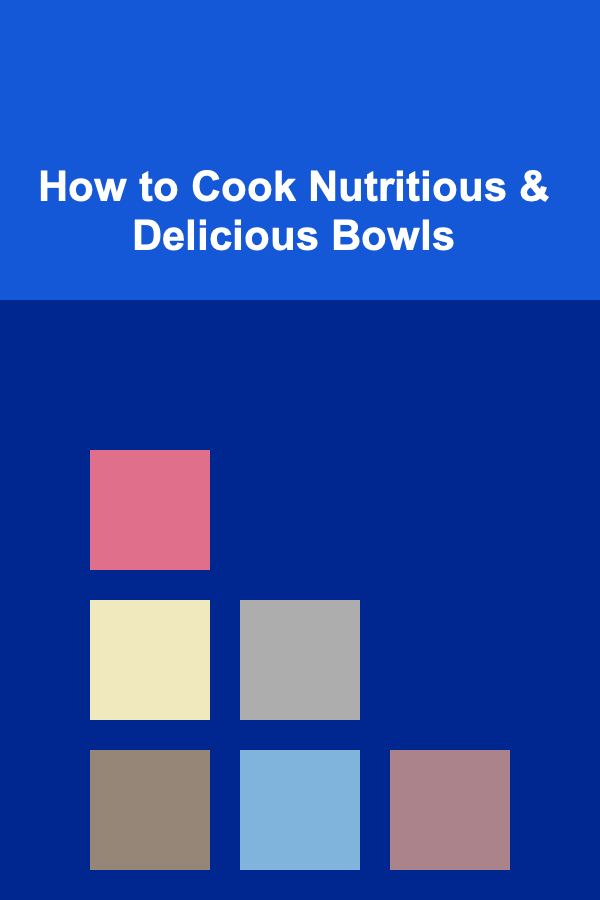
How to Create Printable Activity Books Focused on Early Math Skills
ebook include PDF & Audio bundle (Micro Guide)
$12.99$5.99
Limited Time Offer! Order within the next:
Not available at this time

Creating printable activity books that focus on early math skills is a fantastic way to engage young learners and help them develop essential mathematical concepts in a fun and interactive way. Whether you're a teacher, a homeschooling parent, or an educational content creator, providing children with the right resources can make a significant impact on their ability to grasp foundational math concepts such as counting, addition, subtraction, shapes, and patterns.
In this article, we'll explore how to create engaging, educational, and printable activity books that will captivate young minds while teaching them vital early math skills. We'll break down the process into key steps, from designing the structure of the activity book to including fun activities, ensuring accessibility, and offering tips on how to make the book both educational and entertaining.
Understand the Target Audience
Before you start designing an activity book, it's crucial to understand the developmental stage and age range of your intended audience. Early math skills are typically taught to children between the ages of 3 and 7. At this stage, children are learning to recognize numbers, understand basic math concepts, and begin practicing simple calculations.
Age Groups and Focus Areas:
- Ages 3-4: Focus on number recognition, counting, simple shapes, and basic patterns.
- Ages 4-5: Introduce basic addition and subtraction, more complex shapes, sorting, and sequencing.
- Ages 5-6: Build on addition and subtraction skills, incorporate time concepts, understand greater than/less than, and explore basic measurement.
- Ages 6-7: Strengthen addition and subtraction fluency, introduce simple word problems, explore basic multiplication concepts, and continue practicing measurement and shapes.
Knowing the cognitive abilities of children in these age ranges will guide the type of activities and the complexity of the math concepts you introduce in your activity book.
Actionable Tip:
- Start by focusing on one age group and design the content specifically for their learning needs. This ensures your activities are neither too difficult nor too easy for them to engage with.
Plan the Structure of the Activity Book
The structure of your printable activity book is just as important as the content. A well-organized book helps children navigate through the activities in a logical and enjoyable sequence. Keep in mind that the activities should be visually engaging, with plenty of white space and colorful designs, while maintaining educational value.
Sections to Include in the Book:
-
Introduction: A short, friendly introduction that encourages children to enjoy learning math and explains how the activities work. You could also include a "How to Use This Book" section.
-
Warm-Up Activities: Begin with simple, fun exercises that warm up the child's mind, such as tracing numbers, coloring shapes, or counting objects.
-
Main Activities: This section can feature a range of activities, including:
- Counting exercises (e.g., counting objects, writing numbers)
- Simple addition and subtraction (e.g., math problems with visual aids)
- Shape identification and sorting (e.g., recognizing circles, squares, triangles)
- Pattern recognition (e.g., identifying and completing patterns with objects, shapes, or numbers)
- Measurement activities (e.g., comparing lengths, weights, or volumes)
-
Interactive Games and Puzzles: Make the learning experience enjoyable by adding activities like mazes, crosswords, number puzzles, or "find the missing number" challenges.
-
Review Section: After a series of activities, include a page for the child to review what they've learned. You could incorporate some simple reflection questions or challenges for parents to guide the child through.
-
Certificate of Completion: Children love receiving recognition for their hard work! A printable certificate at the end of the book can celebrate their efforts and motivate them to continue learning.
Actionable Tip:
- Ensure that the activities are sequenced in increasing levels of difficulty to keep the child engaged without overwhelming them.
Use Interactive and Engaging Activities
The core goal of an early math activity book is to make learning fun. If the activities are not engaging, children may quickly lose interest. Therefore, incorporating interactive activities is essential for keeping them motivated and excited about learning math.
Types of Interactive Activities:
- Coloring Pages with Numbers: Children can color pictures of objects (such as animals, toys, or plants) and then count how many there are to reinforce number recognition and counting skills.
- Dot-to-Dot Numbers: These activities are great for helping children recognize number sequences while also improving hand-eye coordination.
- Shape Tracing: Provide templates of basic shapes (circle, square, triangle, etc.) for children to trace with crayons or markers. This helps with both shape recognition and fine motor skills.
- Cut and Paste Activities: Ask children to cut out shapes or numbers from a separate sheet and paste them in the correct sequence, such as ordering numbers from smallest to largest or arranging shapes into patterns.
- Story Problems: Use simple word problems that involve objects children are familiar with, like toys or animals. This helps them connect math to the real world and build problem-solving skills.
- Math Bingo: Create bingo cards with numbers or simple math problems. As you call out the answers, children can mark off their cards.
Actionable Tip:
- Incorporate a variety of activity types---drawing, coloring, matching, tracing, and problem-solving---to keep the child engaged and cater to different learning styles.
Focus on Visual Design and Layout
The layout and design of your activity book play a critical role in attracting and maintaining the attention of young learners. Bright colors, clear fonts, and simple visuals are key to creating an engaging and accessible resource. Avoid cluttered pages, as too much information can overwhelm young children.
Tips for Effective Design:
- Use Bold, Large Fonts: Use large fonts for instructions, questions, and activities so that they are easy for young children to read. Choose friendly, legible fonts like Comic Sans or Century Gothic.
- Include Clear, Simple Instructions: Keep the instructions short, clear, and age-appropriate. Use simple language and visual aids to explain what the child needs to do.
- Use Illustrations and Visuals: Add illustrations of characters, animals, or objects to make the activities visually appealing. This can help the child better understand the concepts and make the experience enjoyable.
- Plenty of White Space: Avoid overcrowding the page with too much content. Use white space effectively to make the layout clean and easy for young learners to follow.
- Incorporate Kid-Friendly Designs: Bright colors and fun designs (like cartoon characters, animals, or nature scenes) will help hold the child's attention. You can also add little surprises like hidden pictures or fun facts throughout the book.
Actionable Tip:
- Keep the layout simple and clutter-free. Test the design on a few children if possible to ensure the format is visually accessible and engaging.
Include Printable Answer Sheets and Instructions for Parents
While the activity book should be child-friendly, it's equally important to provide clear instructions for parents or caregivers. Many activity books include answer sheets and suggestions for how parents can guide the child through more challenging activities.
What to Include:
- Answer Key: An answer key for the activities will help parents or teachers assist the child in solving the exercises and provide explanations for difficult questions.
- Parent Tips: Include suggestions for parents on how to encourage their child's learning. You could offer tips for discussing the concepts, additional activities to try at home, or strategies to make math more fun.
- Additional Resources: For children who need extra support, include links to supplementary resources or suggestions for online games and apps that align with the activity book's content.
Actionable Tip:
- Provide a section at the back of the book with a printable answer sheet and helpful tips for parents to guide the child through more complex activities.
Offer Different Difficulty Levels
Children have different learning speeds and abilities, so it's important to create activities that cater to varying skill levels. Provide a range of activities from beginner to more advanced exercises, or offer optional challenges for children who are ready to stretch their math skills.
How to Structure Difficulty Levels:
- Easy: Simple counting and number recognition activities. These might include counting objects or coloring specific numbers of items.
- Intermediate: Basic addition and subtraction problems, sorting shapes, or completing simple patterns.
- Advanced: Word problems, more complex addition and subtraction, and introduction to multiplication or time concepts.
Actionable Tip:
- Provide a variety of activities that cater to different levels of learners so children can progress at their own pace and feel challenged but not overwhelmed.
Choose a Format for Distribution
Once you've designed your activity book, you need to decide how you will distribute it. There are a few common options for offering printable activity books:
- Downloadable PDFs: Create a digital PDF file that parents, teachers, or caregivers can download and print at home. This is a popular option as it allows for easy distribution and printing.
- Interactive PDFs: For a more engaging experience, you can create an interactive PDF where children can complete certain tasks directly on the computer or tablet. This eliminates the need for printing.
- Online Platforms: Consider offering your activity book through platforms like Teachers Pay Teachers, Etsy, or your own website. This makes it easy for people to purchase and download your content.
Actionable Tip:
- If you're aiming for mass distribution, offering your book as a downloadable PDF or through an online marketplace is the most efficient way to reach a larger audience.
Keep It Fun!
Finally, remember that math should be fun! If you want children to develop a love for math, the activity book must engage them and make learning enjoyable. Use humor, bright colors, and interesting scenarios to keep the learning process lively.
Actionable Tip:
- Include plenty of opportunities for play, creativity, and exploration so that children look forward to completing their activity book.
Conclusion
Creating a printable activity book focused on early math skills requires thoughtful planning, engaging content, and a well-designed layout. By understanding your target audience, providing interactive and visually appealing activities, and focusing on fun and effective learning, you can create a resource that will help young children develop foundational math skills while enjoying the learning process.
The process of creating an activity book can be highly rewarding. Not only are you helping children build essential skills, but you're also fostering a love for learning that can last a lifetime. Whether you're a teacher, a parent, or an educational content creator, your effort in producing high-quality math activity books will have a lasting impact on the educational journey of young learners.

How to Layer Lighting for a Cozy Bedroom Atmosphere
Read More
How to Make Money Online as a Life Coach: 10 Actionable Ideas
Read More
How to Organize Your Home Library by Genre or Author
Read More
How To Unclog a Drain Without Chemicals
Read More
How To Create a Healthy Work-Life Balance Remotely
Read More
How to Cook Nutritious & Delicious Bowls
Read MoreOther Products

How to Layer Lighting for a Cozy Bedroom Atmosphere
Read More
How to Make Money Online as a Life Coach: 10 Actionable Ideas
Read More
How to Organize Your Home Library by Genre or Author
Read More
How To Unclog a Drain Without Chemicals
Read More
How To Create a Healthy Work-Life Balance Remotely
Read More